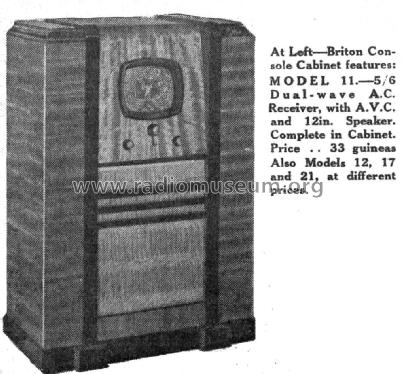- Country
- Australia
- Manufacturer / Brand
- Briton Electrical & Radio Pty. Ltd ("Rational Radio"); Sydney, NSW.
- Year
- 1937
- Category
- Broadcast Receiver - or past WW2 Tuner
- Radiomuseum.org ID
- 167037
Click on the schematic thumbnail to request the schematic as a free document.
- Number of Tubes
- 6
- Main principle
- Superhet with RF-stage; ZF/IF 462.5 kHz; 2 AF stage(s)
- Tuned circuits
- 7 AM circuit(s)
- Wave bands
- Broadcast and Short Wave (SW).
- Power type and voltage
- Alternating Current supply (AC) / 240 Volt
- Loudspeaker
- Electro Magnetic Dynamic LS (moving-coil with field excitation coil) / Ø 12 inch = 30.5 cm
- Material
- Wooden case
- from Radiomuseum.org
- Model: 11 - Briton Electrical & Radio Pty.
- Shape
- Console, Lowboy (legs < 50 %).
- Notes
-
6 valve, dual band, AC powered superhet.
From The Bulletin Sep 22, 1937, Page 41:
A vital point in any dual wave superhet is the short-wave unit, and in the Briton receivers this is a masterpiece of accessibility and rigidity. The shortwave coils and switching mechanism are mounted on a strong metal frame, and wiring is done in heavy-gauge, solid wire.There is no part of the unit that cannot be reached for test or service, a welcome feature for the dealer-serviceman. Iron-core coils on Sirufer cores are used throughout, and the utmost care is taken with impregnation. The impression gained was that these receivers will stand up against any tropical climate.
The 11 is a 5-6 dual-waver selling at 33 guineas and fitted with Philips valves, EF5 (R.F. amplifier), EK2 (frequency converter), EF5 (I.F. amplifier), EBC3 (duo-diode-triode demodulator, combining A.V.C. and first audio), EL3 (high-gain pentode) and EZ3 (indirectly heated rectifier). The advantage of the last named is that until all valves have reached operating temperature no load is applied. The R.F. amplifier works on the short-waves covering from 16 to 45 metres. The audio quality and selectivity satisfy critical ears. Most outstanding is the sensitivity; it was found that changing from a small indoor to a large outdoor aerial made very little difference in the signal gain on London or Berlin. Even with the small aerial background noise was conspicuously absent.
- Price in first year of sale
- 34.00 Aus£
- Circuit diagram reference
- Australian Official Radio Service Manual Vol. I I
- Author
- Model page created by Stuart Irwin. See "Data change" for further contributors.
- Other Models
-
Here you find 82 models, 18 with images and 53 with schematics for wireless sets etc. In French: TSF for Télégraphie sans fil.
All listed radios etc. from Briton Electrical & Radio Pty. Ltd ("Rational Radio"); Sydney, NSW.


